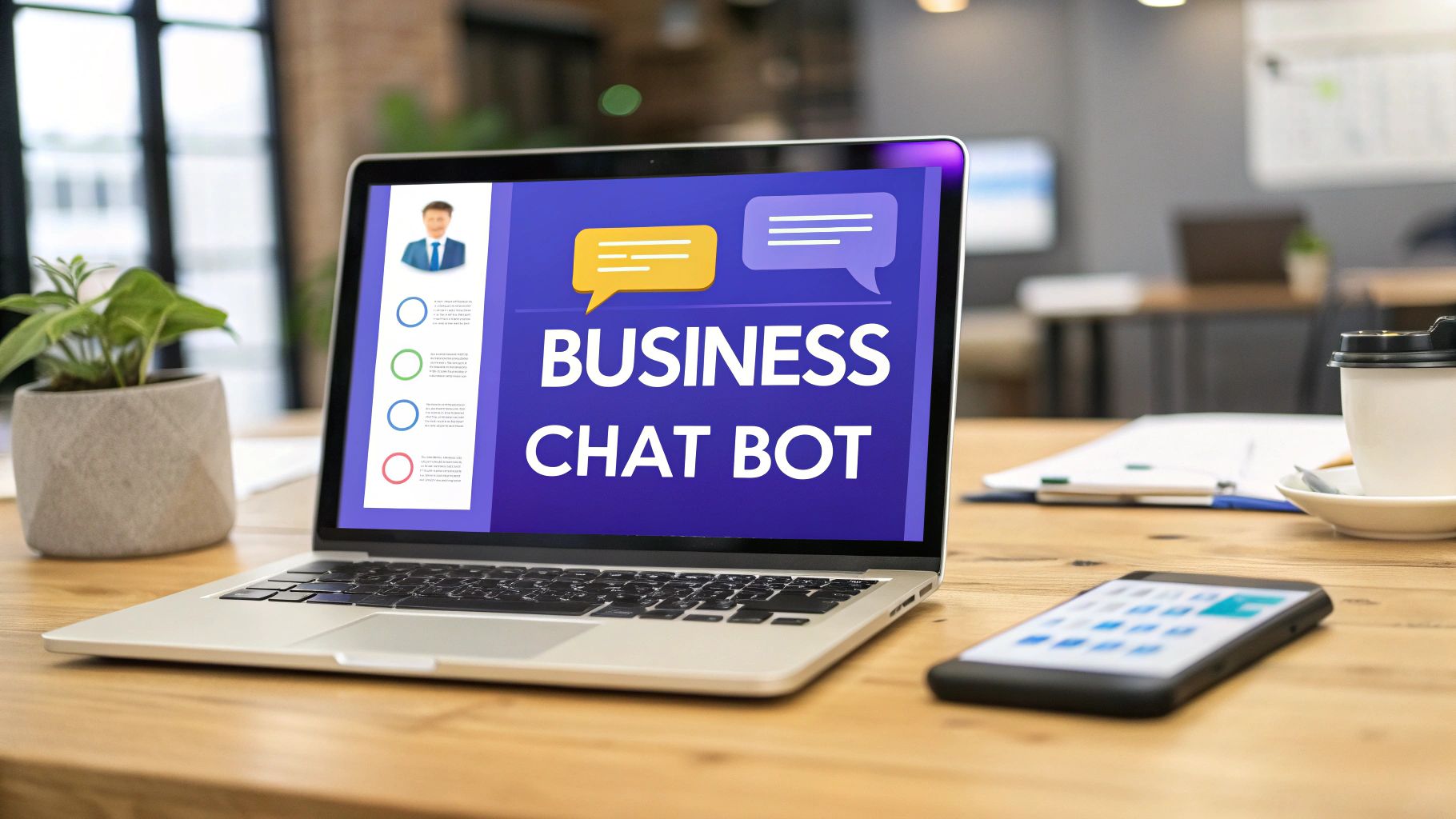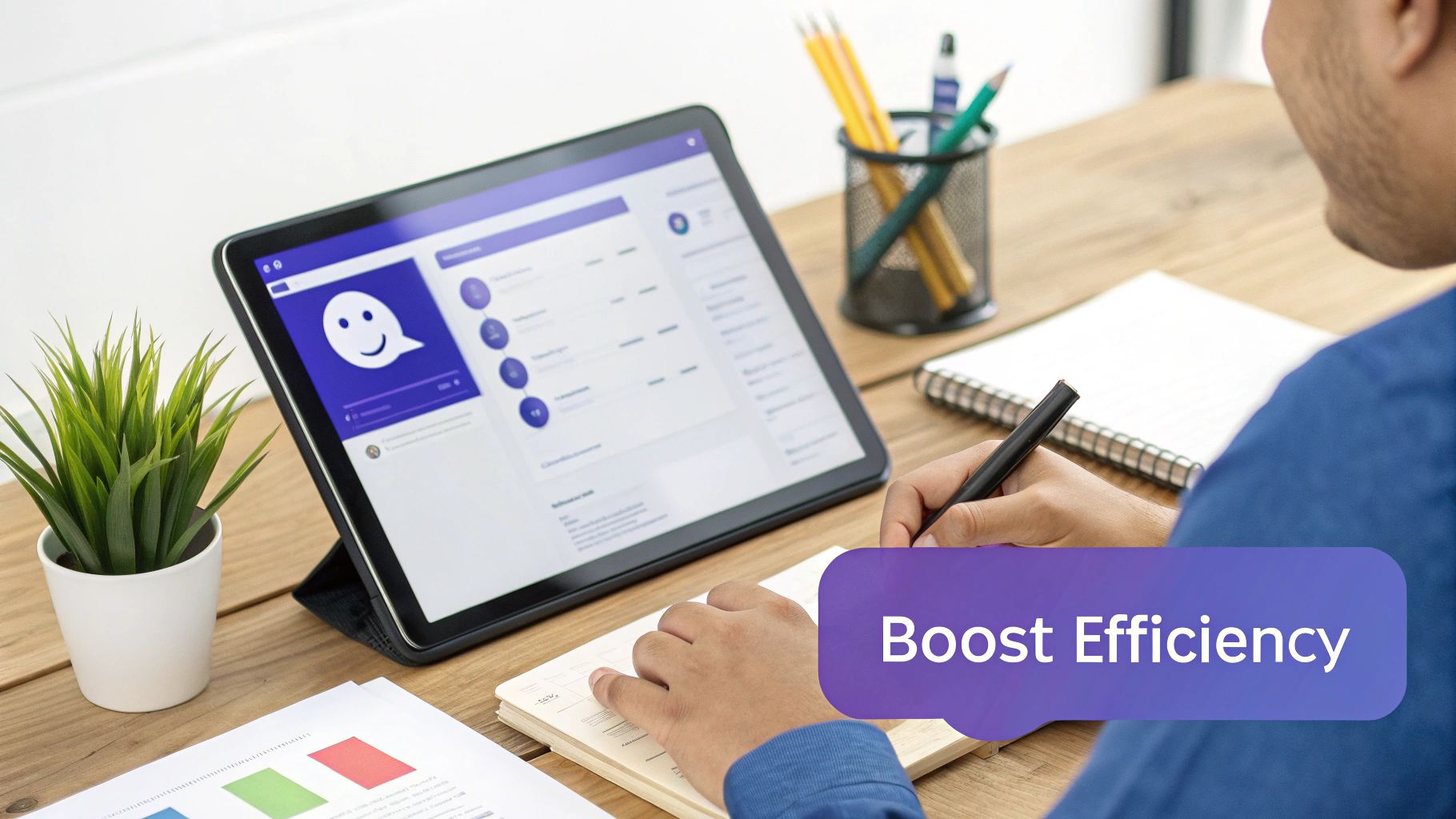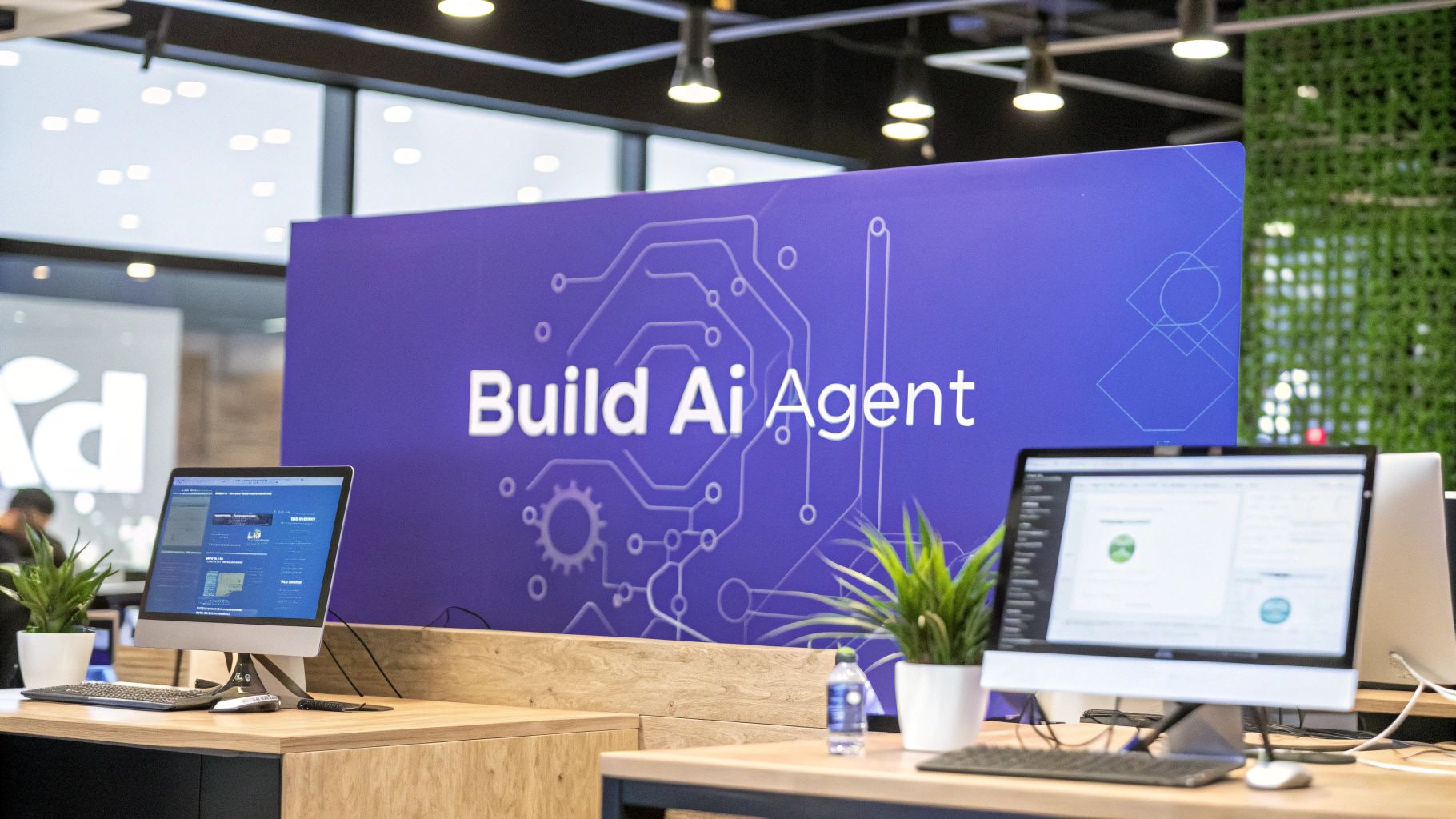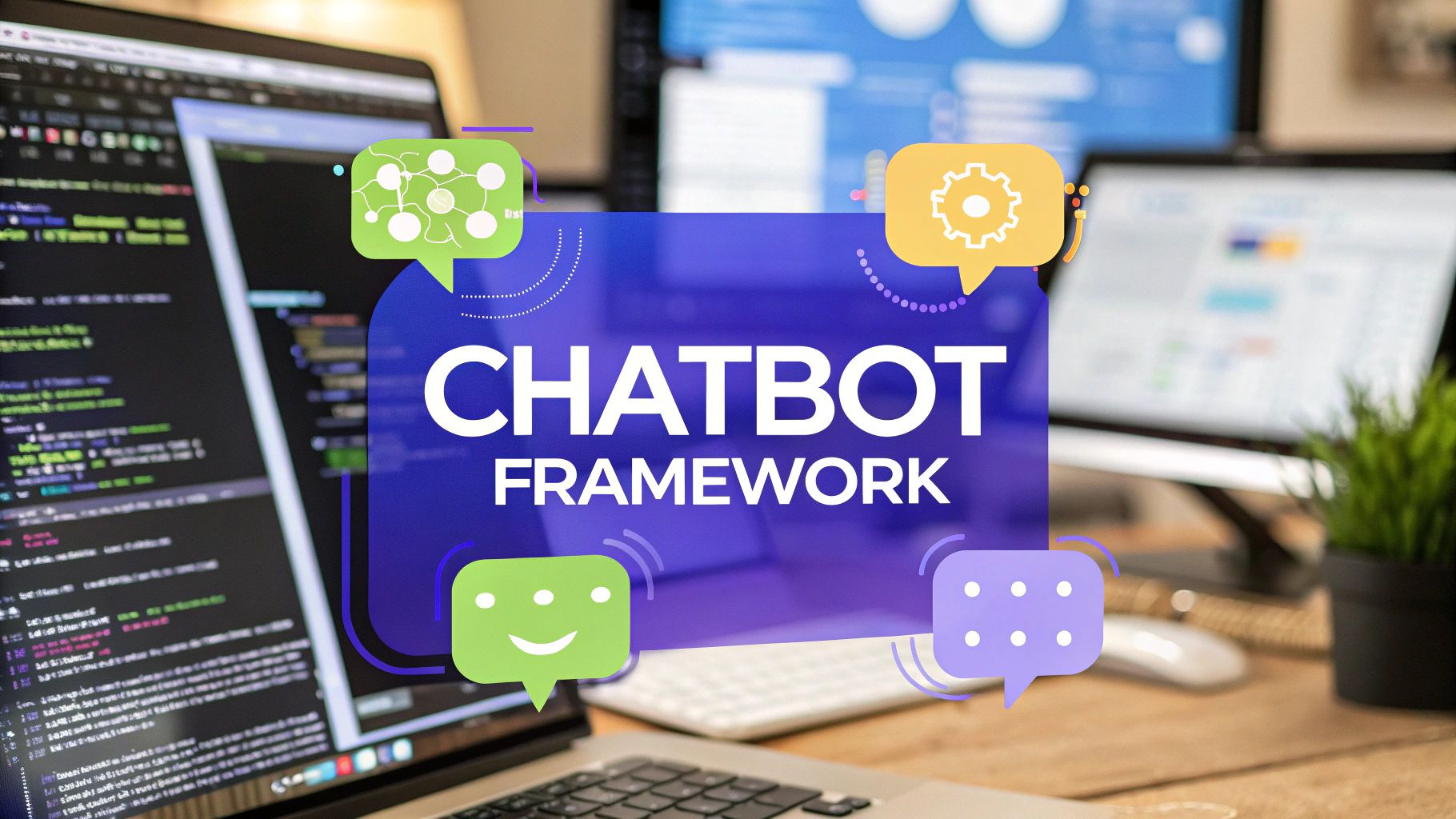Build a Chat Bot That Actually Helps Your Business
Ready to build a chat bot? Our guide shows you how to create, train, and deploy a bot that improves customer support and drives business growth. No code needed.

Thinking about building a chatbot for your business? The fastest way is to use a no-code platform to map out conversation flows, feed the bot your company data, and get it live on your website. This approach lets you build a fully functional bot in just a few hours, without touching a single line of code.
Why Building a Chatbot Is a Smart Business Move
If you're weighing whether a chatbot is worth it, the answer is almost always yes. It's a move that pays dividends by sharpening your operations and improving how customers interact with your brand.
Chatbots are a practical way to automate answers to common questions, giving customers instant support anytime. This means you can offer 24/7 assistance without having to hire more support staff.

Boost Your Operational Efficiency
A chatbot has a direct impact on your bottom line by making your team more efficient. Instead of your staff answering the same questions over and over, they can focus on complex problems that actually need a human touch.
This automation unlocks a few key benefits:
- Cost Savings: You reduce the need for a large customer service team, which saves money on salaries and training.
- Time Management: It frees up your team to work on higher-value activities that drive growth.
- Scalability: A single chatbot can handle thousands of conversations at once, something a human team could never do without a massive investment.
A well-designed bot creates a more responsive and helpful digital presence for your brand. It improves your business by creating a better, more immediate experience for everyone who interacts with your company.
Create a Better Customer Experience
Beyond pure efficiency, a chatbot can seriously upgrade your customer experience. Let's be honest, people appreciate getting answers quickly. A bot gets rid of wait times and provides immediate solutions, which leads to happier, more loyal customers.
The numbers back this up. The global chatbot market was valued at $2.47 billion in 2021 and is expected to hit $15.57 billion by 2025. Experts even predict it will climb to a massive $46.64 billion by 2029, which shows just how many businesses are turning to this tech to connect with their audience. You can dig into more chatbot statistics to see the full picture of this explosive growth.
A chatbot acts as a friendly, always-on front door for your business. It makes your brand more accessible and helpful, building trust with every single interaction.
Choosing the Right Chatbot Building Platform
Picking the right platform is the first real decision you’ll make when you build a chatbot. This choice dictates everything that follows, from how fast you can launch to what the final user experience feels like. The good news is you have options, and they generally fall into two camps: no-code platforms and custom-coded frameworks.
For most businesses, a no-code platform like Chatiant is the most sensible path. These tools are built for people who aren’t developers. They use visual, drag-and-drop interfaces that let you map out conversation flows, connect your data, and get a bot live in no time. You can focus entirely on the conversation design, what the bot should actually do, instead of getting bogged down in code.
On the flip side, custom-coded frameworks offer limitless flexibility but come with a much steeper price tag and the need for a development team. This route is really for organizations with highly specific, complex requirements that off-the-shelf tools just can't handle.
Key Factors in Your Decision
Before you jump in, a few key points will guide your decision. The biggest factor is your team's technical skill. If you don't have developers on staff or their time is already stretched thin, a no-code solution is the obvious choice.
Budget is another major consideration. No-code platforms usually run on a predictable subscription model, making them far more affordable than hiring developers for a custom build, which involves significant upfront and ongoing costs.
Finally, think about your goals. If you need a bot for customer support, lead generation, or an internal helpdesk, a platform like Chatiant already has all the features you'll need built-in.
The global chatbot market was valued at around $7.76 billion in 2024 and is expected to blow past $27 billion by 2030. This boom is happening because platforms are making it incredibly easy for any business to build and deploy helpful bots. You can learn more about chatbot market growth and what's driving it.
Chatbot Platform Comparison: No-Code vs. Custom Code
To make the choice even clearer, let's break down how the two approaches stack up side-by-side. This table should help you figure out which path aligns best with your resources and goals.
A platform's ability to integrate with the tools you already use is what makes it truly powerful. A good no-code builder should connect seamlessly with your CRM, helpdesk software, and communication channels like Google Chat.
If you want a deeper look into how these connections work, check out our guide on how to build a powerful API chat bot. It gives a great overview of how a chatbot can pull and push data to your other business applications, which is where the real magic happens.
A Practical Walkthrough to Building Your First Chatbot
Alright, let's get our hands dirty and actually build a chatbot. For this walkthrough, we'll use Chatiant to show you how fast you can get a bot up and running from scratch, no coding required.
But before you even think about signing up, the entire process starts with a clear goal.
What is this chatbot for? Is it meant to handle common customer questions? Will it capture sales leads? Or is it an internal tool to help your team find company documents? Figuring out its main job will shape every decision you make down the line.
This early planning is more important than most people realize. Taking the time to map things out is a core principle of planning artificial intelligence, and it's what separates a genuinely helpful bot from a frustrating one.
Defining Your Bot's Purpose
Let's use a real-world example. Imagine you run an e-commerce store, and your support team is buried in repetitive questions about shipping policies, returns, and order tracking.
Your goal: build a chatbot to handle these routine queries so your team can focus on more complex customer problems.
With that goal set, the first step is to gather your materials. Pull together your existing FAQ documents, links to your shipping and return policy pages, and any standard email templates you use for these questions. This content is about to become your chatbot's brain.
Setting Up Your First Chatbot in Chatiant
Once you know your bot's purpose, it's time to jump into the platform. Signing up for Chatiant is quick, and you'll land on a simple dashboard that gets you straight to the point.
First, create a new bot and give it a name, something clear like "Customer Support Helper." From there, the platform guides you to add your knowledge sources. This is where all those documents you collected come into play.
- Website Crawling: Just paste your website's URL, and Chatiant will automatically scan the pages to pull in information.
- Document Uploads: Upload your FAQ PDFs, policy documents, and other relevant text files.
- Direct Text Input: For specific questions and answers, you can add them directly to the knowledge base yourself.
Here’s a look at the clean interface you'll be working with inside Chatiant.

The dashboard is designed for clarity, making it easy to manage your knowledge sources and see how your bot is doing at a glance. The no-code approach lets you bypass all the technical hurdles and focus on what really matters: creating a helpful, conversational experience for your users.
Designing Conversation Flows
After feeding your bot its initial knowledge, the next step is designing its conversation flows. This sounds technical, but it’s really just about mapping out how a typical conversation should go. A conversation flow is a visual path a user might take when talking to your bot.
For our e-commerce example, a common flow would look something like this:
- User Asks: "Where is my order?"
- Bot Responds: "I can help with that. What is your order number?"
- User Provides Order Number: "12345"
- Bot Looks Up Status: (This is where you could set up an action to check your order database).
- Bot Delivers Answer: "Your order #12345 has shipped and is scheduled for delivery tomorrow."
In Chatiant, you build these flows with a visual drag-and-drop editor. You create different "intents" (the goals a user has) and then define the bot's responses and actions for each one. This makes structuring logical conversations feel intuitive, even if you're a complete beginner.
How to Train Your Chatbot to Be More Effective
Building a chatbot is just step one. Think of it like a new hire, it has the basic skills, but it needs the right training to actually become a valuable part of your team. This training process is what transforms a generic bot into a smart, knowledgeable assistant that truly understands your customers and your business.
The first part of training is all about building a solid knowledge base. You need to feed your bot the right information so it has something useful to say when people start asking questions.
A great place to start is by uploading your existing company materials directly into a platform like Chatiant. This gives your bot an immediate foundation to work from.
- Website Content: Let the bot crawl your website. This is the fastest way for it to learn about your products, services, and general company info.
- Documents: Have user manuals, policy documents, or internal guides? Upload them as PDFs so the bot can pull answers directly from them.
- FAQs: If you already have a list of frequently asked questions, give it to the bot. This is a head start on handling the most common queries.
This initial data dump forms the core of your bot's "brain," giving it the raw material it needs to handle a wide range of topics from day one.
Refining Your Bot’s Understanding
Just having the information isn't enough. Your bot needs to understand the countless ways people might ask for it. This is where intents and training phrases come into play. An intent is simply the user's goal. What are they trying to do? Examples could be "check order status" or "ask about return policy."
For each intent, you'll want to provide a handful of different training phrases. Let's say the intent is asking about shipping. People might phrase this in a bunch of ways:
- "How much is shipping?"
- "What are your delivery options?"
- "Do you ship to Canada?"
By feeding it these variations, you're training the bot's Natural Language Processing (NLP) model to recognize the user's goal, even when the wording isn't a perfect match. It’s what makes the conversation feel natural instead of clunky and robotic.
Training isn't a "set it and forget it" task. It's an ongoing process. You'll constantly discover new ways people ask questions, and adding these phrases to your bot's training will make it smarter and more effective over time.
Using Conversation Logs for Improvement
So, how do you know what to teach your bot next? Simple: listen to its conversations. Reviewing conversation logs is probably the single most important thing you can do to improve your bot's performance.
Keep an eye out for moments where the bot misunderstood a question or gave a generic, unhelpful "I don't know" response. These are goldmines for improvement. When you spot a failed conversation, you have two clear actions you can take:
- Update the Knowledge Base: If the bot didn't have the information, add it. Maybe that means creating a new FAQ entry or uploading a document that covers the topic.
- Add Training Phrases: If the bot had the right info but didn't get the user's question, add their exact phrasing as a new training example for the correct intent.
This feedback loop is what makes a chatbot truly intelligent. To take this even further and get more precise responses, it's worth exploring advanced strategies like mastering few-shot prompting techniques. For a deeper look into this continuous improvement cycle, check out our guide on how to train a chatbot.
Getting Your Chatbot Live on Your Website and Apps
A chatbot sitting in a dashboard doesn't do much good. The real value comes when it's live, interacting with people where they already are. Once you’ve built your bot, the next move is to get it out there on the platforms your customers and team use every day. Thankfully, this process is pretty straightforward, especially with platforms designed for easy integration.

We'll walk through how to connect your new bot to a few popular spots: Webflow, WordPress, and Google Chat. Each one has a simple integration method, which means you can go live quickly without having to loop in a developer.
Before you push your chatbot live for everyone to see, it’s a smart move to test it on a staging or development site first. This lets you iron out any kinks and make sure the bot works perfectly on different browsers and devices without disrupting the experience on your main site.
Adding Your Chatbot to a Webflow Site
Integrating your chatbot with a Webflow site is surprisingly simple. Most no-code platforms, including Chatiant, give you a small piece of JavaScript code that you can pop directly into your project.
You'll usually find this code in your chatbot platform's dashboard, likely under a "Publish" or "Integrations" section. Once you have it, the process is just a few clicks inside Webflow:
- Head over to your Webflow project’s Site Settings.
- Click on the Custom Code tab.
- Paste the code snippet into the Footer Code box.
- Save your changes and publish your site.
That’s all it takes. The chatbot widget will now show up on every page of your Webflow site, ready to help your visitors.
Integrating with a WordPress Website
For anyone using WordPress, the process is just as painless, and often even easier thanks to plugins. You could use the same JavaScript method by adding the code to your theme's header or footer, but a dedicated plugin can get you up and running faster.
Many chatbot providers offer their own WordPress plugin that handles the connection for you. All you have to do is install the plugin, link it to your chatbot account with an API key (which you'll find in your platform's dashboard), and tweak the appearance settings. This approach is great because it keeps your theme files clean and lets you manage the bot right from your WordPress admin panel.
To get into the details, you can check out our detailed guide on how to add a chatbot to your website.
Connecting to Google Chat for Internal Use
Chatbots are not just for talking to customers. They can be incredibly powerful tools for your own team when you connect them to a platform like Google Chat. An internal bot can become a company helpdesk, instantly answering questions about HR policies, finding documents, or explaining internal processes.
Connecting a bot to Google Chat usually involves setting up what’s called a webhook integration. Inside your chatbot platform, you'll select Google Chat as a channel and follow the prompts to authorize the connection. The platform will give you a unique webhook URL, which you then add to a specific Google Chat space.
This creates a dedicated "AI agent" right inside your team's main communication hub. Team members can ask the bot questions directly in a chat room, getting instant answers without having to interrupt their colleagues or dig through a cluttered knowledge base.
Common Questions About Building a Chatbot
If you're thinking about building a chatbot, you've probably got a few questions. That's a good thing. Getting the right answers upfront helps you set clear expectations and avoid common pitfalls.
Let's walk through some of the most frequent questions people ask when they're getting started.
How Much Does It Really Cost to Build a Chatbot?
This is usually the first question on everyone's mind, and the answer comes down to one thing: how you choose to build it.
If you go the no-code route, you can get started for free on many platforms and scale up as you grow. Paid plans typically range from a small monthly fee to a few hundred dollars, depending on the features and traffic you need. It’s a predictable and budget-friendly way for most businesses to get a powerful bot without a huge upfront cost.
Building a fully custom bot with developers, on the other hand, is a whole different ballgame. That kind of project starts at several thousand dollars and can easily climb into the tens of thousands. For most small and medium-sized businesses, a no-code platform like Chatiant hits the sweet spot between capability and affordability.
How Quickly Can You Launch a Chatbot?
The next big question is always about the timeline. With a no-code tool, you can move surprisingly fast. It’s entirely possible to build and launch a simple FAQ bot in just a few hours. Seriously.
If your bot is more complex, say, it has multiple conversation paths or needs to integrate with other tools, you might spend a few days or a week getting it right. The initial setup is quick; the real value comes from training and refining it over time to make it smarter.
Key Differences Between Chatbot Types
People often wonder what's going on under the hood. What’s the actual difference between a basic rule-based bot and a modern AI chatbot?
- Rule-based chatbots are like flowcharts. They follow a strict, pre-programmed script and can only respond to specific commands. If a user asks a question in a way the bot doesn't recognize, it gets stuck.
- AI chatbots use natural language processing (NLP) to understand what a user actually means, not just what they type. This lets them handle different phrasings and follow the natural flow of a conversation, making the experience feel much more human.
Do You Need to Be a Developer?
Finally, there’s the technical question. Do you need to know how to code to build a chatbot?
The answer is a firm no.
Modern chatbot platforms are built for non-technical users. With intuitive drag-and-drop interfaces and visual builders, anyone can create, train, and deploy a sophisticated bot without writing a single line of code.
Ready to create a smart AI assistant for your business? With Chatiant, you can build a chatbot trained on your own data in minutes, not months. Start building your free chatbot today.


